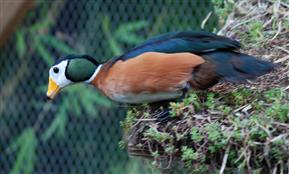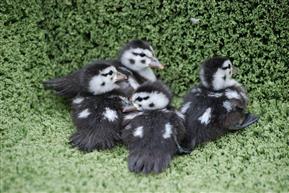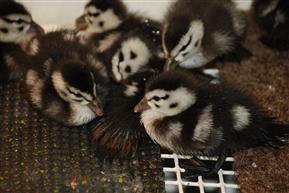African Pygmy Geese - nettapus auritus
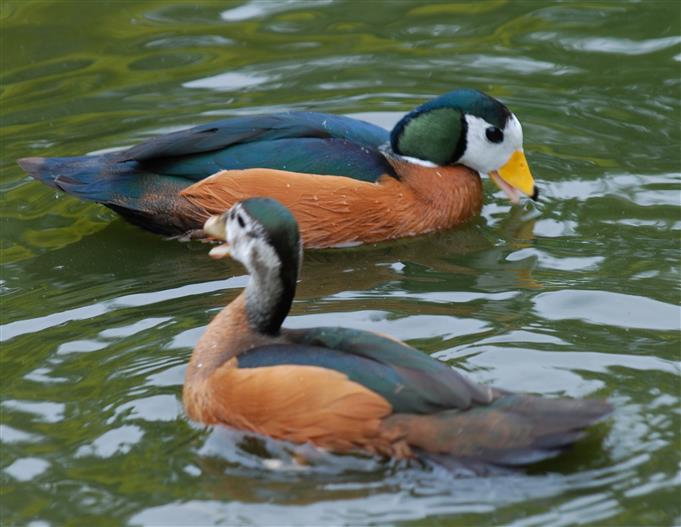
In the wild pygmy geese spend most of their life on the water but do also frequently perch on overhanging branches of dead trees and are only rarely seen on land. They have very short legs and consequently do not walk well on land and for this reason they are much better maintained full winged in an aviary. Unlike many species of waterfowl their flight is very agile and if disturbed they will take flight but even in relatively small aviaries it is unusual for them to collide with the sides of the aviary so flight can be enjoyed in a very natural way. If housed in an aviary where they are the only waterfowl they will thrive but can be kept with other species if care is taken. When the Africans are in breeding condition they will try and dominate other species that may be significantly larger and while this is not a problem there is always the risk that the larger species may turn on the African pygmy and inflict significant damage so it is much safer to keep them on their own.
Sadly African pygmy geese have a reputation of being difficult to maintain in captivity, they are certainly not easy but provided a few simple rules are followed they are not nearly as difficult as much of the literature suggests. While African pygmies are diminutive they are certainly not shrinking violets, unless a very significant area can be provided it is my contention that it is virtually impossible to maintain two or more pairs together when they are in breeding condition. It is possible to keep a trio together for most of the year and the male will give every indication that he is well paired to both females. However, when the male is in full condition they need to be watched because he can become very aggressive towards the female that he is not really paired with.
African pygmy geese become quite tame and confiding and if they are offered a small quantity of mealworms each day the process of taming them can be speeded up. Their desire for mealworms very quickly helps them overcome any fear that they may initially have and it is certainly possible to entice them to even take mealworms from the hand. In captivity the principal diet is a variety of mixed seed, a good quality Foreign Finch mixture works very well. Small pellets or chick crumbs should also be offered but in reality very little of this will be consumed. While I rear the young on crumbs and mini pellets and do not introduce seed to the diet until they are almost full grown it is quite incredible how quickly the pygmies abandon all the pellets and crumbs and only really consume the seed, mealworms and quantities of green food in the form of lettuce, spinach and cabbage leaves all of which are consumed eagerly. While a good quality Foreign Finch mixture works well I do now make up my own mixture that is used for all the pygmy geese, I will include the recipe on separate tab within the pygmy geese section.
For most of the year African pygmy geese can be expected to display when you approach the aviary with much head bobbing twittering sounds coming mainly from the female as she frantically incites the male. The display is probably more associated with the defence of their territory but always gives the impression that they are pleased to to you. In reality I think the female is frantically encouraging the male to defend their territory. When the pair are in full breeding condition the male will quite frequently fly towards you when you approach and then immediately rush back to his female and enter into much head bobbing and calling to one another. It is all so exaggerated that they almost have a clown like appearance and any additional effort required to maintain them is more than amply rewarded by their dynamic characters.
Pygmy geese do appreciate reasonable water quality but because they are so small this is relatively easy to achieve by various methods. Most of my pygmy geese are maintained on ponds where the water is filtered using conventional filters designed for fish keeping. If the water is kept clear it is also possible to keep fish in the ponds and this can add another dimension of interest that is not possible with many other species of waterfowl. The fish also provide an early warning system regarding the quality of the water, if he fish show signs of distress by swimming near the water surface and gasping then you know the water quality is rapidly deteriorating. It may be possible to resolve the problem by air rating the water but if this does not resolve the problem then clean the pond out immediately otherwise there will also be problems with the Pygmy geese.
African pygmy geese give every indication that they are fully mature in their first season, males are certainly fertile but the females do not appear to lay until the second year. However in the first season the males will certainly encourage the females to enter nest boxes and the females do everything you would expect except lay. When they are in their second season their plumage will really start to glisten as the days lengthen and the temperature rises and the first eggs can be expected in the UK from mid May onwards. African Pygmy geese have quite a long season and can lay from the middle of May until the end of August.
Male African pygmy geese take a very active part in nest site selection, a variety of raised nest boxes should be provided but the requirements do not appear to be particularly exacting. As the pair come into breeding condition the male will start flying up to nest boxes and calling quite loudly and very soon afterwards the female will also start flying up to the chosen nest box. The males do not actually enter the nest box but really do appear to actively encourage the female to inspect the box. Once a nest box has been selected the female will very quickly start to make a nest. With most species of waterfowl the female will make little more than a depression ,scrape, one or two days prior to laying the first egg. Female African Pygmy Geese make quite a deep scrape in the nest box and if straw is available in the box they will line the scrape and effectively make much more of a nest prior to laying the first egg than any other species of waterfowl that I have kept.
African Pygmy Geese
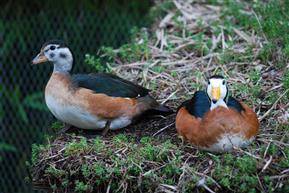
Pair of African pygmy geese, note how obviously heavy 'in lay' the female is.
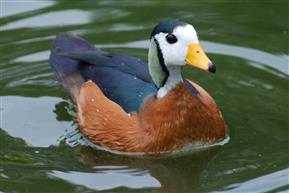
Male African Pygmy goose.
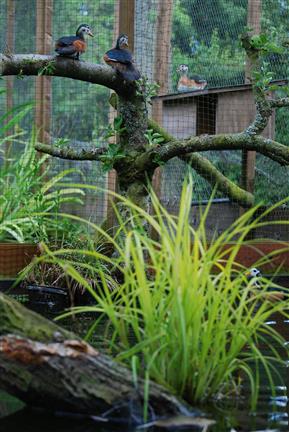
Adult female African pygmy geese, they enjoy being able to perch on branches over the water.
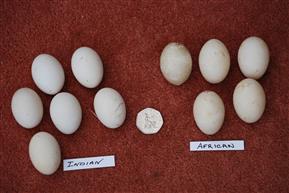
African and Indian Pygmy Goose eggs for comparison.
